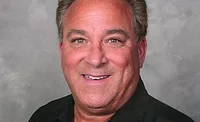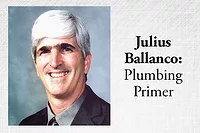Keep it Cool With Radiant
Radiant COOLING?
Summertime. Not only is it a time for hitting the beach, grilling your dinner outdoors and maybe taking in a baseball game or two, but it's when many homeowners turn to thoughts of their old air conditioning systems.
They'll crank the temperature setting on their thermostats to a comfortable level and then wait as the box outside sputters to life, sputtering and roaring, shaking and rattling. And the payoff? An anemic stream of cool-ish air coming out of the registers, along with puffs of most everything that's collected in the vents since the last time the system was fired up.
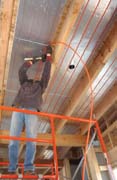
An installer from Ken Hastey Plumbing gets a workout installing PEX tubing in the ceiling of a custom home in Santa Fe for a radiant cooling and heating system. Photo courtesy of Watts Radiant/Tom Brahl.
The same scenario plays out every autumn as homeowners fire up the furnace for the first time in search of something to warm up a cool house. For them, though, the widespread availability of radiant and radiant hydronic heating systems has been a godsend-set the thermostat and the house is warm. Period. No dust blown inside from dirty vents, no coughing, wheezing machinery-just almost transparent comfort.
Well, the same thing can be done with cooling. It's an old technology that's not the most common thing out there, but it's beginning to shake off the cloak of relative anonymity.
Just like radiant heating, radiant cooling systems can provide quiet, effective cooling at minimal operating cost. It's not quite as easy as adding a chiller to an existing radiant floor heating system, though. And installation of radiant cooling systems is best left in the new construction arena rather than retrofit at the moment.
Larry Drake, executive director of the 900-member Radiant Panel Association in Loveland, Colo., said the association fields inquiries regarding radiant floor cooling on a regular basis: "It is a natural question," Drake said.
"It's reasoned that a forced air distribution system can be used to both heat and cool, why not radiant floors? This is logical reasoning and needs to be addressed, but first we should recognize that adding air-conditioning to a forced air heating system requires compromise as well," Drake said.
He explained that close to half the output of a heated floor is from natural convection-cool air coming in contact with the warm floor, rising, giving up heat and falling to be heated once again. Without the assistance of natural convection, floor cooling capacity is about half that of floor heating.
"As may be obvious at this point, a cooled ceiling has much more cooling capacity than a cooled floor because rising warm air will contact the ceiling, be cooled, fall to the room below where it will absorb heat and rise to be cooled again," he said.
In simpler terms, a radiant cooling system will work better in a structure's ceiling, while a radiant heating system will work best in the floor. Cooling in the ceiling and heating in the floor is a function of where the greatest heat transfer can take place-areas near the ceiling are usually warmer, so a radiant cooling panel there will be able to transfer more heat. Areas near the floor tend to be cooler, so a radiant heating panel there will be able to transfer more heat.
"Certainly radiant doesn't care whether it's on the floor or the ceiling. Where you do get into a problem there is with your heat transfer," said Ken Hastey, for 25 years the owner of Ken Hastey Plumbing, Inc., in Santa Fe, N.M. Hastey recently completed work on a 5,000 square foot custom home in the area equipped with both radiant heating and cooling systems.
"The best heat transfer happens where you have your greatest delta-T [temperature differential]," Hastey said. "You have your greatest heat-to-cool delta-T at the ceiling and your greatest cool-to-heat delta-T at the floor."
The installation of a radiant cooling system in this particular house was dictated, in part, by the home's location, climate and construction. Santa Fe has a perfect climate for radiant cooling and heating systems. It's average annual high temperatures are about 85 degrees Fahrenheit, while the average annual low temperature hovers near 16 F, and the humidity level-an important consideration with a radiant cooling system-is very low during the summer months. Homes in the area are typically Pueblo-style with no attics, flat roofs and slab-on-grade construction. That doesn't offer a lot of places to put ductwork.
Helping out in designing the system for the job was Jay Maze, a heating and cooling design specialist at Dahl Wholesale Plumbing & Heating in Santa Fe, who estimated that nearly 90 percent of new construction in the area is radiant-equipped.
"And it's been that way for a long time," Maze said, adding the company's showroom has been radiant cooled for the past six years. "Maybe it's because we have an ideal climate for it, but it's something that's the norm-it's just how things are done here. So radiant cooling would be a natural transition."
Maze said that, while the climate for radiant cooling in Santa Fe is quite suitable, it may not be the best thing in other parts of the country but, "it's taking off here quite well."
"We haven't historically had a lot of cooling in Santa Fe but, as our houses get bigger and our clients get wealthier, they feel that they need it," Hastey said. "The alternative to putting ductwork up above is putting ductwork in the slab and that's a big headache for everybody."
Hastey said the heat loss calculation for the radiant heating system in the building showed there was more heat loss than could be replaced with a radiant system in the slab by itself because of the number of windows, doors and walls exposed to the outside.
"So we were going to need supplemental heat," Hastey said. "We talked about it and decided to put it in the ceiling as well and, if we were going to put it in the ceiling, why don't we run cold water through it during the summer so we can cool the house as well?"
Cooling Challenges
One of the largest challenges facing radiant cooling systems is condensation. Think of a radiant cooling system like a cold beverage in a glass outside on a hot day. The outside of the glass becomes wet very quickly because its surface temperature, because of the cold liquid inside, is at a temperature below the dew point of the surrounding air.
[Basically speaking, the "dew point" is that temperature at which water vapor present in the air will condense into visible water. This temperature can vary from day-to-day at any given location, depending on a number of factors.-Ed.]
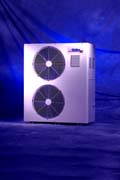
The chiller, like this light commercial unit manufactured by Unico, Inc., in St. Louis, is the heart of any radiant cooling system. And, since it's a reverse-flow unit, it could be used to provide some heating as well. Photo courtesy of Unico, Inc.
Condensation on radiant surfaces-the ceiling in this case, may actually create indoor "rain" in worst-case situations.
The Hydronics Institute division of the Gas Appliance Manufacturers Association lists the outdoor design temperature in Santa Fe-for heat loss calculation purposes-as 10 degrees Celsius, which is 50 F. As long as the temperature of the water circulating in the cooling system stays above this level, most condensation issues will be avoided.
Maze said the water circulates through the cooling system at temperatures ranging between 55- and 60 F: "We had to put a Honeywell temperature sensor outside of the building," Maze said. "It calculates the dew point and sends information to a 3-way mixing valve that controls the temperature of the water in the system. It's actually a European Honeywell control and we got to learn a lot about it because we were one of the first ones in the country to use it."
The System
The cooling system in this house simply consists of grooved metal sheets holding half-inch Watts Radiant PEX tubing installed in the ceiling. The PEX runs into the mechanical room in the garage and on to a light commercial chiller outside. There are also heating loops installed in the ceiling for supplemental radiant heat.
The system's chiller was sized, Hastey said, by performing a heat gain calculation for the cooling system: "A heat loss calculation [for radiant heating] basically tells you how much ability your structure has to lose heat through windows and doors and other openings. A heat gain calculation is just the opposite-it tells you how much heat you're going to gain because of those same openings.
The chiller chosen was a light commercial unit manufactured by Unico, Inc., of St. Louis. It's is a refrigerant-to-water unit that was installed outside the residence. Hastey and company ran copper lines to it and added glycol for protection. That is in turn plumbed to a flat-plate heat exchanger in the mechanical room, space shared with the heating system's Laars boiler.
"At that point, it gives up its coolness to plain water which is held in an 80-gallon buffering tank," Hastey said. "From there it just pumps through the tubing like hot water would in a radiant heating system. By flipping a switch, we can make the system heat or cool via the same pipes."
Maze said setting up a radiant cooling system to operate properly is a slightly different proposition than the same process for a radiant heating system.
"It's a lot touchier to get correct because the temperature differentials you're working with are much tighter," he said. "With a heating system, you may be running 140-degree water through the system while the outside temperature is 10 degrees so you're looking at a 130-degree delta-T. With radiant cooling, we're looking at maybe 60-degree water and maybe a 90-degree outside temperature. That's a 30-degree delta-T so we don't have nearly the margin of favorable heat transfer. You have to make sure things are right to make it work."
Will it Catch On?
A basic knowledge of the way radiant cooling systems work indicates they aren't the right kind of setup for all applications in all areas of the country.
A radiant cooling system installed on New Orleans' Bourbon St., for example, in a building with operable windows is going to provide inhabitants with a very unpleasant experience because of the high amounts of water vapor (humidity) in the air, coupled with relatively high temperatures.
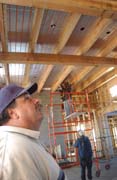
Ken Hastey checks the progress during the installation of a radiant cooling system in a 5,000 square foot custom home in Santa Fe. Photo courtesy of Watts Radiant/Tom Brahl.
"We do see radiant cooling installed around the country," RPA's Drake said. "In areas were humidity is a factor the system has to be accompanied by a dehumidification system. Still, it is more comfortable and more economical to operate that standard forced air cooling."
Which, of course, begs the Big Question: will radiant cooling getting more attention in other areas of the country and start taking off like radiant heating systems have over the past few years? Maze said it's difficult to say.
"We go to all of the trade shows around the country and see that radiant is getting big, but it's hard to tell what's happening with the rest of the country," he said. "We talk to people all over the country and it's certainly coming in-people are asking us questions all the time. The feeling is hard to describe-it's like the difference between convection heat and radiant heat. I have it in my own house and, once you've lived with it, it's a lot more comfortable."
"This article was originally posted on ww.reevesjournal.com."
Looking for a reprint of this article?
From high-res PDFs to custom plaques, order your copy today!




